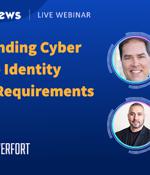Security News

One solution to help organizations protect themselves is cyber insurance, despite the rising costs of cyber insurance, where the average price in the U.S. rose 79% in the second quarter of 2022. While cyber insurance is not a one-size-fits-all solution and may not cover every possible scenario, it can help organizations mitigate the financial and reputational risks associated with cyber-attacks and data breaches.

In this Help Net Security video, Fawaz Rasheed, Field CISO at VMware, discusses how cyber insurance remains the high tide that rises ships. For organizations choosing to purchase cyber insurance, the requirements set forth towards them are beneficial in advancing their security program.

Protect your website or app from DDoS attacks with Gcore's global DDoS protection service. Small and medium-sized enterprises may need help meeting the cyber insurance requirements that keep company data safe.

The Hacker News is thrilled to announce the launch of our new educational webinar series, in collaboration with the leading cybersecurity companies in the industry! Get ready to dive into the world of enterprise-level security with expert guests who will share their vast knowledge and provide you with valuable insights and information on various security topics. Skyrocketing claims in 2020 sent shockwaves through the insurance industry, forcing insurance providers to reinvent the criteria for acquiring or renewing cyber insurance.

Among these are a mandate to enforce multi-factor authentication across all admin access in a network environment as well as protect all privileged accounts, specifically machine-to-machine connections known as service accounts. How do you compile an accurate list of every admin user? While some can be easily identified - for example, IT and helpdesk staff - what about so-called shadow admins? These include former employees that may have left without deleting their admin accounts, which then continue to exist in the environment along with their privileged access.

SMBs are aware of increasing cyber threats and allocating resources and investing in areas such as network and cloud security, according to Datto. 69% of SMBs currently have cyber insurance and 34% of those without cyber insurance are highly likely to get it in the next year.

In 2022, significant geopolitical developments have led to equally significant changes within the cyber insurance market. In this Help Net Security video, Chris Denbigh-White, Global Director of Customer Success for Next DLP, discusses how, with the increasing number of breaches, insurers are left with no choice but to increase premiums, making the notion of insuring cyber risk unrealistic, leaving businesses paying the highest premiums to date.

Notably, survey results reveal that more than 68% of founders have experienced a cyber attack on one of their businesses - which may address why 86% of founders surveyed already have some cyber insurance protections in place. The high percentage of startups with cyber insurance can partially be attributed to pressures from investors and/or board members, as nearly half cite cybersecurity insurance protections as required by one or both of these entities.

With cybersecurity threat vectors evolving every day and with attackers employing a more innovative and unpredictable approach through combining various types of attack, it's no surprise that the global cyber insurance market is expected to grow from a worth of $7bn in gross written premiums in 2020 to $20.6bn by 2025, according to GlobalData. In this Help Net Security video, Manoj Bhatt, Head of Security and Advisory at Telstra Purple, discusses how with increasing product complexity and compliance requirements, ever-rising product premiums, and access to cover restricted for many organizations, many security teams are questioning the value of cover in the first place.

The rise in the costs of data breaches, ransomware, and other cyber attacks leads to rising cyber insurance premiums and more limited cyber insurance coverage. This cyber insurance situation increases risks for organizations struggling to find coverage or facing steep increases.